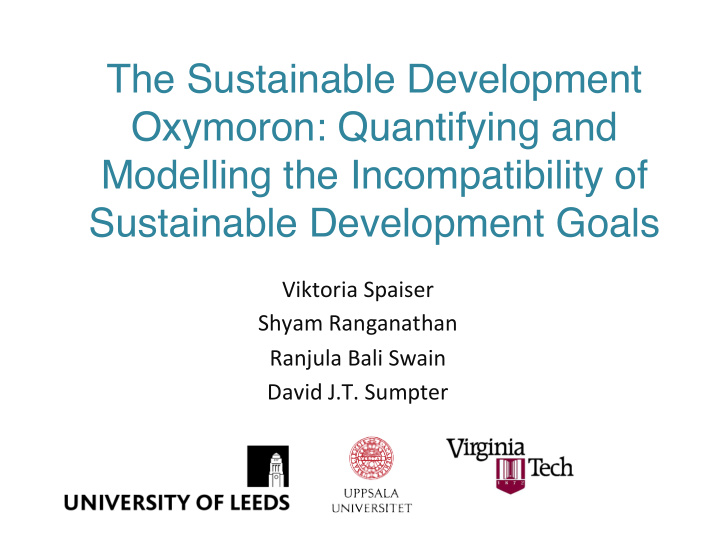



The Sustainable Development Oxymoron: Quantifying and Modelling the Incompatibility of Sustainable Development Goals Viktoria Spaiser Shyam Ranganathan Ranjula Bali Swain David J.T. Sumpter
Sustainable Development Goals (SDG)
Data (RevoluBon) for SDGs * * World Bank Data API 1432 economic, social, poliBcal and environmental indicators, 217 countries, years 1980-2013, finally used 233 indicators
Are SDGs consistent? A 1.0 GINI Violence 0.5 Factor Dimension 2 Protected.Sea 80 Hunger Water Education 60 Unemployment.Youth Sanitation 0.0 Internet Poverty CO2.emissions 40 Child.Mortality Alternative.Energy 20 Women.Parliament Air.Pollution Protected.Land − 0.5 − 1.0 − 1.0 − 0.5 0.0 0.5 1.0 Factor Dimension 1
Are SDGs consistent? EFA-suggested model, CFA confirmed: B GINI Vio .78 .68 Inequality & Violence (Factor Dimension 2) Development (Factor Dimension 1) .90 .91 .73 .90 .93 .92 .60 -.53 .30 CM Pov Hun Wat* San* Ed* Int* CO2 AP
Model Latent Variable ( L ), by CFA ProporBon Variance: .73 4 CO2.emissions SDL Factor Dimension 2 Child.Mortality 2 .821 .981 -.531 E d u c a t i o n CO2 0 CM Edu R 2 =.673 R 2 =.282 R 2 =.961 − 2 − 2 0 2 Factor Dimension 1 Model Fits CFA: CFI: .973; TLI: .931; RMSEA: .031; SRMR: .063 CFA factor scores for L used to create Model Latent Variable L (Latent Variable 1 )
Finding predicBve models Method 1. Feature SelecBon: Variable EliminaBon Algorithm, using Ensemble PLS, accounBng for nonlineariBes è best predictors 2. Data-driven Dynamical Systems Modeling: Model CombinaBon Approach & Bayesian Model SelecBon with best predictors selected by Feature SelecBon Algorithm, iteraBve
Data-driven Dynamical Systems Modeling Model Selec+on: 1. Log Likelihood (pre-selecBon): 2. Bayes Factor (final selecBon): at higher order iteraBon steps only Bayes Factor Model Combina+on Approach : CombinaBon of increasing complexity (number of terms) of polynomial terms
Best-fit Models for change of L D : Net foreign assets (indebtedness) G : GDP per capita F r : Fertility rate R f : Women’s economic rights J : Independence of Judicary N d : Natural depletion costs 0.5 0.5 2 GDP per capita 6 Fertility rate 4 0 0 8 6 10 8 − 0.5 − 0.5 2 4 6 2 4 6 Net foreign assets Net foreign assets 0 0.5 Independent Judicary − 0.22 0.5 5 − 0.24 SDL 1 0 10 − 0.26 1.5 15 − 0.28 2 − 0.5 − 0.3 0 1 2 3 0 2 4 Womens economic rights Natural Depletion
Factors contribuBng to incompaBbility Factors showing a way out Dynamical Systems Models for the three pillars 1. End Poverty (Model for changes in Child Mortality): 2. Socio-economic inclusion (Model for changes in EducaBon): 3. Environment (Model for changes in CO2 emissions): G : GDP per capita C : Final consumption expenditure F r : Fertility rate E r : Renewable energy production M : Measles immunication N d : Natural depletion costs W g : Government spending E m : Particulate emission damage
Monitoring Sustainable Development SDG index 1 Based on L model − 0.6 1
The SDG index vs. HDI and GDP SDG index 1 predicts HDI predicts GDP per capita predicts 54% of changes in child 41% of changes in child 17% of changes in child mortality mortality mortality 6% of changes in educaBon 4% of changes in educaBon 2% of changes in educaBon 21% of changes in CO2 0.7% of changes in CO2 0.4 % of changes in CO2 emissions emissions emissions 16% of changes in L 7% of changes in L 4% of changes in L
For more informaBon… Working Paper on SSRN: hgp://papers.ssrn.com/sol3/papers.cfm?abstract_id=2766875
Recommend
More recommend